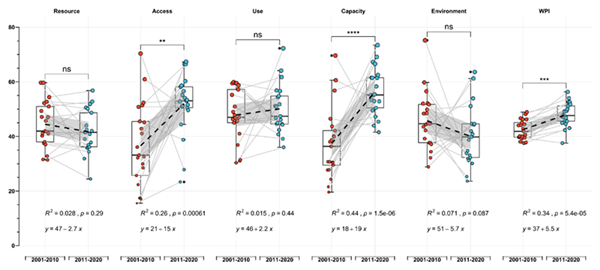Socioeconomic Drought in the Arid Area of Northwest China Shows a Slowing Trend: Study
2023-05-22
Limited amount of surface water resources and ground water resources is the primary cause of socioeconomic drought in the Arid Area of Northwest China (AANC), but reasonable human activities in recent years have alleviated the pressure of resource-based water shortage and contributed to the alleviation of socioeconomic drought in the AANC, from severe to moderate drought.
The Arid Area of Northwest China is the most serious region of resource-based water shortage in China, where engineering-, structural-, and management-based water scarcity coexist, and the research on the types of water shortage in each region (city and state) is still in the stage of qualitative analysis. Chen Yaning's research team at the Institute of Ecology and Geography, Chinese Academy of Sciences, recently provided an in-depth analysis of this issue.
Based on data related to water resources development and utilization, Chen’s team constructed a water poverty index (WPI) to characterize socioeconomic drought. The team adopted various clustering methods to comprehensively analyze the relative degrees and types of water scarcity in different regions. And they also used structural equation model to identify the main factors affecting socioeconomic drought and their contribution rates.
"In addition to resource-based water shortage, the Arid Area of Northwest China also presents engineering and management-based water shortages coexist," said Chen Yaning. There are different types of key water shortages in each region (city and state), their study found. "In the past five years, the degree of socioeconomic drought in the AANC has eased and shows a tendency to change to moderate drought," Chen said.
Socioeconomic drought in the Arid Area of Northwest China is affected by many factors, including resources, access, capacity, use and environment.
Each of these sub-indices reflects the background value of water resources in the study area while also reflecting the economy, management, environment, use structure and other social factors in relation to the overall impact of water resources.
"The interactions and chains among the factors are complex," said Li Zhi. The contribution of each sub-index to the WPI are 36.58% for Resource, 18.29% for Access, 15.36% for Capacity, 15.52% for Use, and 14.25% for Environment.
Studies on drought types in the Arid Area of Northwest China have mostly focused on meteorological drought, agricultural drought, hydrological drought, and the transmission and lagging relationships among the three drought types, while quantitative studies on socioeconomic drought are scarce, ignoring the important economic and social drivers of water scarcity.
The research provides a reference framework for the construction of socioeconomic drought evaluation index systems in arid zones and a scientific reference for the comprehensive assessment of drought changes and water resources management decisions in the northwest region under the influence of global changes, according to Li Zhi.
Results of the study, entitled "The spatiotemporal evolution of socioeconomic drought in the Arid Area of Northwest China based on the Water Poverty Index", has been published in Journal of Cleaner Production. Wang Jiayou, first author; Li Zhi, corresponding author.
This study was supported by the Natural Science Foundation of Xinjiang Uygur Autonomous Region and the National Natural Science Foundation of China.

Fig. 1. Intergenerational changes in the WPI and its sub-indices. Note that ns indicates not significant; * indicates significance strength, with more indicating greater significance; R2 indicates the model decision coefficient; and p-value indicates the significance level, with smaller values indicating greater significance. (Image by Wang Jiayou)
Contact:
LIU Jie
Xinjiang Institute of Ecology and Geography
Tel: 86-0991-7885505
E-mail: liujie@ms.xjb.ac.cn
Web: http://english.egi.cas.cn/



